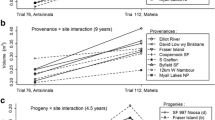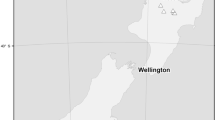Abstract
Aims
The objective of this study was to compare the merit of the Colombian landrace relative to the various Australian native races of Eucalyptus globulus Labill. ssp. globulus and study the genetic control of key traits such as growth, wood density, and leaf phase change in the unique conditions of the Colombian highlands.
Methods
The genetic study was based on open-pollinated families from native Australian and Colombian landrace origin, tested across four trials spanning two generations of breeding. A multisite mixed linear model with genetic groups was fitted to the data to estimate race merit and the variance and covariances between traits, ages, and sites.
Results
Race effects for growth were small and only significant at the older site. In contrast, races differ significantly for height to phase change and density. The Colombian landrace and South and NE Tasmania races changed leaf type at a higher tree height. King Island and Recherche Bay had low density values, whereas the Colombian landrace had the highest. Heritability was moderate for growth traits (between 0.09 and 0.40), high for height to phase change (between 0.42 and 0.69), and moderate for wood density (0.28). The genetic correlation between growth and height to phase change was in general positive, but variable across sites. There was no correlation between growth and density. Despite large differences in growth between trials, pairwise genetic correlations suggest that genotype-by-site interaction is negligible. However, there was a poor correspondence between first-generation (ex-native stands) and second-generation families (ex-multi-provenance progeny trial). This suggests that breeding value estimates based on native open-pollinated material are unreliable.
Conclusion
Results confirm negligible race differences for growth, but not for wood density. Future breeding efforts should include the various genetic backgrounds including the Colombian landrace which constitutes a very important source, especially because of its high density. Despite a low Genotype by Environment interaction, the poor genetic correspondence between the first- and second-generation trials indicates that selections for growth should be based on information coming mainly from the advanced-generation trials.
Similar content being viewed by others
References
Borralho NMG, Cotterill PP, Kanowski PJ (1992a) Genetic parameters and gains expected from selection for dry weight in Eucalyptus globulus ssp. globulus in Portugal. Forest Sci 38:80–94
Borralho NMG, Cotterill PP, Kanowski PJ (1993) Breeding objectives for pulp production of Eucalyptus globulus under different industrial cost structures. Can J Forest Res 23:648–656
Borralho NMG, Kanowski PJ, Cotterill PP (1992b) Genetic control of growth of Eucalyptus globulus in Portugal. II. Efficiencies of early selection. Silvae Genet 41:70–77
Borralho NMG, Potts BM (1996) Accounting for native stand characteristics in genetic evaluations of open-pollinated progeny from a Eucalyptus globulus base population. New Forest 11:53–64
Brennan EB, Weinbaum SA (2001) Performance of adult psyllids in no-choice experiments on juvenile and adult leaves of Eucalyptus globulus. Entomol Exp Appl 100:179–185
Costa-e-Silva J, Potts BM, Dutkowski G (2006) Genotype by environment interaction for growth of Eucalyptus globulus in Australia. Tree Genet Genomes 2:61–75
Costa-e-Silva J, Potts BM, Hardner CM (2010a) Genetic variation and parental performance under inbreeding for growth in Eucalyptus globulus. Ann Forest Sci 67:606. doi:https://doi.org/10.1051/forest/2010019
Costa-e-Silva J, Hardner CM, Tyliard P, Potts BM (2010b) Effects of inbreeding on population mean performance and observational variances in Eucalyptus globulus. Ann Forest Sci 67:605. doi:https://doi.org/10.1051/forest/2010018
de Little DW, Foster SD, Hingston TL (2008) Temporal occurrence pattern of insect pests and fungal pathogens in young Tasmanian plantations of Eucalyptus globulus Labill. and E. nitens Maiden. Pap Proc R Soc Tasmania 142:61–69
Da Y, Grossman M (1991) Multitrait animal model with genetic groups. J Dairy Sci 74:3183–3195
Dutkowski GW (1995) Genetic variation in drought susceptibility of Eucalyptus globulus ssp. globulus in plantations in Western Australia. In: Potts BM, Borralho NMG, Reid JB, Cromer RN, Tibbits WN, Raymond CA (eds) Eucalyptus plantations: improving fibre yield and quality. CRC-IUFRO, Hobart, pp 199–203
Dutkowski GW, Potts BM (1999) Geographic patterns of genetic variation in Eucalyptus globulus ssp. globulus and a revised racial classification. Aust J Bot 47:237–262
Dutkowski GW, Potts BM (2012) Genetic variation in the susceptibility of Eucalyptus globulus to drought damage. Tree Genet Genomes 8:757–773
Eldridge K, Davidson J, Harwood C, van Wyk G (1997) Eucalypt domestication and breeding. Oxford Science Publications, Oxford
Freeman J, Marques CMP, Carocha V, Borralho NMG, Potts BM, Vaillancourt RE (2007) Origins and diversity of the Portuguese landrace of Eucalyptus globulus. Ann Forest Sci 64:639–647
Gilabert H, Paci C (2010) An assessment of volume–ratio functions for Eucalyptus globulus and E. nitens in Chile. Cienc Investig Agrar 37:5–15
Gilmour AR, Cullis BR, Welham SJ, Thompson R (1998) ASREML users’ manual. New South Wales Agriculture, Orange
Greaves BL, Borralho NMG, Raymond CA (1997) Breeding objective for plantation eucalypts grown for production of kraft pulp. Forest Sci 43:465–472
Greaves BL, Borralho NMG, Raymond CA (2003) Early selection in eucalypt breeding in Australia—optimum selection age to minimise the total cost of kraft pulp production. New Forest 25:201–210
Hamilton MG, Williams DR, Tilyard PA, Pinkard EA, Wardlaw TJ, Glen M, Vaillancourt RE, Potts BM (2013) A latitudinal cline in disease resistance of a host tree. Heredity 110:372–379
Hardner CM, Vaillancourt R, Potts BM (1996) Stand density influences outcrossing rate and growth of open-pollinated families of Eucalyptus globulus. Silvae Genet 45:226–228
Hodge GR, Volker PW, Potts BM, Owen JV (1996) A comparison of genetic information from open-pollinated and control-pollinated progeny tests in two eucalypt species. Theor Appl Genet 92:53–63
Hunter GC, Crous PW, Carnegie AJ, Wingfield MJ (2009) Teratorphaeria nubilosa, a serious leaf disease pathogen of Eucalyptus ssp. in native and introduced areas. Mol Plant Pathol 10:1–14
Jones RC, Vaillancourt RE, Gore PL, Potts BM (2011) Genetic control of flowering time in Eucalyptus globulus ssp. globulus. Tree Genetic Genomes 7:1209–1218
Jordan G, Potts BM, Wiltshire RJ (1999) Strong, independent, quantitative genetic control of the timing of vegetative phase change and first flowering in Eucalyptus globulus ssp. globulus (Tasmanian Blue Gum). Heredity 83:179–187
Jordan G, Borralho NMG, Tyliard P, Potts BM (1994) Identification of races in Eucalyptus globulus ssp. globulus based on growth traits in Tasmania and geographic distribution. Silvae Genet 43:292–298
Jordan G, Potts BM, Chalmers P, Wiltshire RJ (2000) Quantitative genetic evidence that the timing of vegetative phase change in Eucalyptus globulus ssp. globulus is an adaptive trait. Aust J Bot 48:561–567
Kottek M, Grieser J, Beck C, Rudolph B, Rubel F (2006) World map of the Köppen–Geiger climate classification updated. Meteorol Z 15:259–263
Lopez GA, Potts BM, Dutkowski G, Apiolaza L, Gelid P (2002) Genetic variation and inter-trait correlations in Eucalyptus globulus base population trials in Argentina. Forest Genetic 9:214–231
Lynch M, Walsh B (1998) Genetics and analysis of quantitative traits. Sinauer Associates, Sunderland
Matheson AC, Raymond CA (1984) Effects of thinning in progeny tests on estimates of genetic parameters in Pinus radiata. Silvae Genet 33:125–130
McCullagh P, Nelder JA (1989) Generalized linear models, vol. 37. Monographs on statistics applied probability. Chapman & Hall, London
Milgate AW, Potts BM, Joyce K, Mohammed C, Vaillancourt RE (2005) Genetic variation in Eucalyptus globulus for susceptibility to Micosphaerella nubilosa and its association with tree growth. Australas Plant Pathol 34:11–18
Muneri A, Raymond CA (2000) Genetic parameters and genotype-by-environment interactions for basic density, pilodyn penetration and stem diameter in Eucalyptus globulus. Forest Genet 7:317–328
Orme RK (1978) Eucalyptus globulus provenances. Documents FAO. Third World Consultation on Forest Tree Breeding, vol. 1, Canberra, pp 207–221
Patterson B, Vaillacourt RE, Pilbeam DJ, Potts BM (2004) Factors affecting variation in outcrossing rate in Eucalyptus globulus. Aust J Bot 52:773–780
Potts BM, Vaillancourt RE, Jordan G, Dutkowski G, Silva JC, McKinnon G, Steane D, Volker P, Lopez G, Apiolaza L, Li Y, Marques C, Borralho NMG (2004) Exploration of the Eucalyptus globulus gene pool. In: Borralho NMG, Pereira JS, Marques C, Coutinho J, Madeira M, Tomé M (eds) Proceeding of IUFRO Conference “Eucalyptus in a changing world”. RAIZ, Aveiro, pp 46–61
Raymond CA, Apiolaza LA (2004) Incorporating wood quality and deployment traits in Eucalyptus globulus and Eucalyptus nitens. In: Plantation forest biotechnology for the 21st century. Research Signpost, Kerala, India, pp 87–99
Salas M, Salazar M (2007) Evaluación Fenotípica del huerto semillero de Eucalyptus globulus La Florida y determinación del protocolo de injertación orientado a la propagación de individuos sobresalientes. Universidad Distrital Francisco José de Caldas, Bogotá
Soria F, Borralho NMG (1997) The genetics of resistance to Phoracantha semipunctata attack in Eucalyptus globulus in Spain. Silvae Genet 46:365–369
Squillace AE (1974) Average genetic correlations among offspring from open-pollinated forest trees. Silvae Genet 23:149–156
Stackpole DJ, Vaillancourt RE, Aguigar M, Potts BM (2010) Age trends in genetic parameters for growth and wood density in Eucalyptus globulus. Tree Genetic Genomes 6:179–193
Steinbauer MJ (2002) Oviposition preference and neonate performance of Mnesampela provata in relation to heterophylly in Eucalyptus dunnii and E. globulus. Agr Forest Enthomol 4:245–253
Venegas L (1989) Instalación y manejo de un huerto semillero de Eucalyptus globulus Labill en Cololombia. Investigación Forestal, vol. 25. INDERENA, Bogotá
Volker PW (2002) Quantitative genetics of Eucalyptus globulus, E. nitens and their F1 hybrid. University of Tasmania, Hobart
Volker PW, Orme K (1988) Provenance trials of Eucalyptus globulus and related species in Tasmania. Austral For 51:257–265
Wei X, Borralho NMG (1996) A simple model to describe age trends in heritability in short rotation tree species. In: Dieters MJ, Matheson AC, Nikles DG, Harwood CE, Walker SM (eds) IUFRO Conference on Tree Improvement for Sustainable Tropical Forestry. QFRI, Caloundra, Queensland, pp 178–181
Westell RA, Quaas RL, van Vleck LD (1988) Genetic groups in an animal model. J Dairy Sci 71:1310–1318
Acknowledgments
The establishment and maintenance of the second-generation trials has been a joint effort between Smurfit Kappa Cartón de Colombia S. A. (SKCC), Reforestadora El Guásimo, Reforestadora del Caribe S. A. S, Corporación Nacional de Investigación y Fomento Forestal—CONIF, Universidad Distrital “Francisco José de Caldas”. The project has been partially financed by the Ministério de Agricultura y Desarrollo Rural (contract no. 348/2006, agreement no. 002/2006 alliance IICA-MADR) and Colciencias. We would also like to thank Hugo España (SKCC) and colleagues and to all the forestry students who, under the leadership of Professor Jairo Silva, have been responsible for maintaining and measuring the La Florida site over the years.
Author information
Authors and Affiliations
Corresponding author
Additional information
Handling Editor: Jean-Michel Leban
Contribution of the co-authors
Salas, M., Nieto, V: designed the research.
Salas, M., Perafán, L., López, A., and Nieto, V.: performed the research.
Borralho, N., Salas, M., and Perafán, M.: analyzed the data.
Borralho, N., Salas, M., and Nieto, V.: wrote the paper.
Rights and permissions
About this article
Cite this article
Salas, M., Nieto, V., Perafán, L. et al. Genetic parameters and comparison between native and local landraces of Eucalyptus globulus Labill. ssp. globulus growing in the central highlands of Colombia. Annals of Forest Science 71, 405–414 (2014). https://doi.org/10.1007/s13595-013-0342-4
Received:
Accepted:
Published:
Issue Date:
DOI: https://doi.org/10.1007/s13595-013-0342-4




